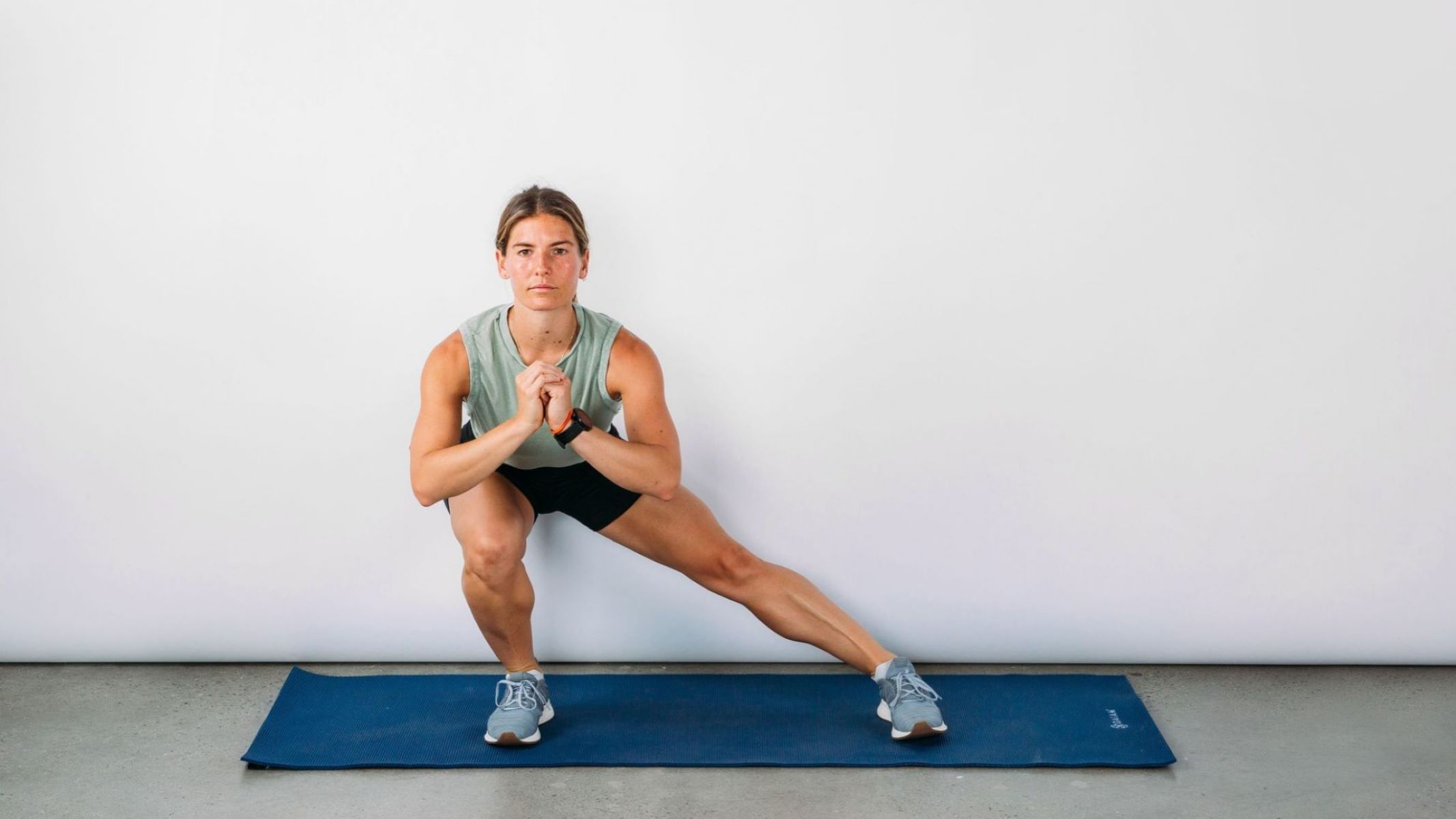Home>Misc>Featured>How To Do Interval Training On A Stationary Bike


Featured
How To Do Interval Training On A Stationary Bike
Modified: August 19, 2023
Learn how to do interval training on a stationary bike with our featured guide. Boost your cardio and burn calories effectively.
Introduction
Welcome to the world of interval training on a stationary bike! Whether you’re a fitness enthusiast looking to shake up your workout routine or a beginner just starting your fitness journey, interval training on a stationary bike is a fantastic way to burn calories, build stamina, and improve cardiovascular health.
Interval training involves alternating between periods of high-intensity exercise and periods of lower intensity or rest. This type of training not only challenges your body but also keeps your workouts interesting and motivating. The stationary bike is an excellent choice for interval training because it provides a low-impact, customizable workout that can be adjusted to fit your fitness level.
In this article, we will explore the benefits of interval training on a stationary bike, guide you through setting up your bike for optimal performance, and provide beginner, intermediate, and advanced level interval training workouts. We will also offer tips for a successful training session and guide you through the cool-down and stretching phase to promote recovery and prevent injury. So, let’s get ready to pedal our way to better fitness and health!
Benefits of Interval Training on a Stationary Bike
Interval training on a stationary bike offers a multitude of benefits for your physical and mental well-being. Let’s dive into some of the key advantages of incorporating this type of training into your fitness routine:
- Burns more calories: The high-intensity intervals in your workout help to increase your heart rate and metabolism, resulting in a higher calorie burn both during and after your workout. This makes interval training on a stationary bike a great choice for those looking to shed some extra pounds.
- Improves cardiovascular health: The alternating intensity levels of interval training challenge your cardiovascular system, increasing both your heart and lung capacity. Over time, this can lead to improved cardiovascular health, making everyday activities feel easier and enhancing your overall endurance.
- Builds muscle strength: Pedaling against resistance during the high-intensity intervals helps to strengthen and tone your lower body muscles, including your glutes, quadriceps, hamstrings, and calves. Interval training on a stationary bike can help you achieve lean and sculpted legs.
- Time-efficient workouts: One of the major advantages of interval training is its time efficiency. With shorter, intense bursts of exercise followed by periods of rest or lower intensity, you can achieve the same or even better results in a fraction of the time compared to traditional steady-state cardio workouts.
- Boosts endorphin levels: Interval training releases endorphins, often referred to as “feel-good” hormones. These endorphins can improve your mood, relieve stress, and promote a sense of well-being. The high-intensity intervals also provide an exhilarating and challenging workout experience, leaving you feeling energized and accomplished.
- Versatility and adaptability: Interval training on a stationary bike can be tailored to suit individuals of different fitness levels and goals. Whether you’re a beginner or an advanced cyclist, you can customize the intensity, duration, and resistance levels to match your abilities and continuously challenge yourself as you progress.
These are just a few of the many benefits you can experience from interval training on a stationary bike. With consistent effort and a well-rounded approach, you can achieve remarkable fitness gains while enjoying the ride.
Setting Up Your Stationary Bike for Interval Training
Before diving into your interval training session, it’s important to ensure that your stationary bike is properly set up for optimal performance and safety. Follow these steps to get your bike ready for a successful workout:
- Adjust the seat height: Stand next to your bike and position the seat at hip height. This will allow for proper leg extension and prevent strain on your knees during the pedaling motion.
- Position the seat horizontally: The seat should be positioned so that it offers a slight bend in your knees when your feet are placed on the pedals. Avoid having your knees fully extended or excessively bent.
- Adjust the handlebar height: The handlebars should be adjusted to a height that feels comfortable for you. Aim for a relaxed position that allows your elbows to have a slight bend when gripping the handlebars. Ensure that your back remains straight during the entire workout.
- Check the pedal straps: Make sure that the pedal straps are securely fastened to keep your feet in place during the workout. This will prevent your feet from slipping and ensure a smooth and efficient pedaling motion.
- Set the resistance: Adjust the resistance on your stationary bike to a level that challenges you, but still allows you to maintain good form and pedal smoothly. The higher the resistance, the more challenging the workout will be.
Take a few moments to familiarize yourself with the various buttons and features on your stationary bike. Check if it has built-in interval training programs that you can utilize or if you will need to manually control the intensity and duration of your intervals. Understanding the functions of your bike will make it easier to adjust and customize your workouts.
Now that your bike is properly set up, you’re ready to hit the pedals and take on the exhilarating world of interval training!
Warm-up and Safety Precautions
Before diving into your interval training session, it’s essential to warm up your body and take necessary safety precautions to prevent injuries. Follow these guidelines to ensure a safe and effective workout:
1. Warm-up: Start your workout with a 5-10 minute warm-up to gradually increase your heart rate and prepare your muscles for the upcoming intensity. You can warm up by pedaling at a moderate pace, gradually increasing your speed and resistance.
2. Proper form: Maintain proper form throughout your workout. Keep your back straight, shoulders relaxed, and core engaged. Avoid hunching over or gripping the handlebars too tightly.
3. Listen to your body: Be mindful of your body’s signals during your workout. If you experience any pain, dizziness, or shortness of breath, take a break or slow down. It’s important to push yourself, but not to the point of overexertion or risking injury.
4. Stay hydrated: Drink water before, during, and after your workout to stay hydrated. Interval training can be intense, and it’s crucial to replenish fluids to maintain optimal performance and prevent dehydration.
5. Use proper footwear: Wear cycling shoes or sneakers with a sturdy sole to provide support and stability. This will help you maintain a strong connection with the pedals and reduce the risk of slipping or injury.
6. Gradually increase intensity: If you’re new to interval training, start with shorter intervals and lower intensity. Gradually increase the duration and intensity of your intervals as your fitness level improves. This will allow your body to adapt and minimize the risk of overexertion or muscle strain.
7. Cool down and stretch: After your workout, take 5-10 minutes to cool down by pedaling at a slower pace. Follow this with gentle stretching exercises to improve flexibility and prevent muscle tightness.
By following these warm-up and safety guidelines, you’ll minimize the risk of injuries and create a solid foundation for a successful interval training session. Remember, safety should always be a top priority in any exercise routine.
Beginner Level Interval Training Workout
If you’re new to interval training or just starting your fitness journey, this beginner level interval training workout on a stationary bike is a great way to get started. This workout will gradually introduce you to higher intensity intervals while allowing for adequate rest and recovery. Remember to adjust the resistance and duration of intervals based on your fitness level and comfort.
Warm-up: Start with a 5-minute warm-up, pedaling at a moderate pace and low resistance to prepare your body for the workout.
Interval 1 – Moderate Intensity: Start with a 2-minute interval of moderate intensity. Increase your speed and resistance slightly, aiming for a comfortably challenging effort level. Focus on maintaining a consistent pace throughout the interval.
Recovery: Follow the moderate intensity interval with a 2-minute recovery period. Reduce the resistance and pedal at a slower pace to allow your heart rate to lower and catch your breath.
Interval 2 – High Intensity: Next, perform a 1-minute interval at a high intensity level. Increase the resistance and pedal as fast as you can without sacrificing proper form. This should be a challenging effort, but you should still be able to complete the interval.
Recovery: Take a 2-minute recovery period after the high-intensity interval. Lower the resistance and pedal at a slower pace to recover and prepare for the next interval.
Repeat: Repeat the cycle of moderate intensity and high intensity intervals followed by recovery periods for a total of 4 rounds. As you progress, you can increase the number of repetitions gradually.
Cool-down and Stretching: Finish your workout with a 5-minute cool-down, pedaling at a slow pace and low resistance to gradually bring your heart rate down. Follow this with gentle stretching exercises to relax and stretch your muscles.
Remember, as a beginner, it’s important to listen to your body and start at a comfortable intensity. Focus on building endurance and gradually increasing the intensity and duration of your intervals over time. Stay consistent, and you’ll be amazed at how quickly your fitness improves.
Intermediate Level Interval Training Workout
If you’ve been consistently participating in interval training and are looking to take your fitness to the next level, this intermediate level interval training workout on a stationary bike will provide a challenging and rewarding experience. Adjust the resistance and duration of intervals based on your fitness level and comfort, pushing yourself to new limits.
Warm-up: Start with a 5-minute warm-up, pedaling at a moderate pace and low resistance to prepare your body for the workout.
Interval 1 – Moderate Intensity: Begin with a 3-minute interval of moderate intensity. Increase the resistance, focusing on maintaining a steady pace and challenging effort level throughout the interval.
Recovery: Follow the moderate intensity interval with a 90-second recovery period. Reduce the resistance and pedal at a slower pace to allow your heart rate to lower and catch your breath.
Interval 2 – High Intensity: Next, perform a 2-minute interval at a high intensity level. Increase the resistance and pedal as fast as you can, pushing yourself to reach your maximum effort while maintaining proper form.
Recovery: Take a 90-second recovery period after the high-intensity interval. Lower the resistance and pedal at a slower pace to recover and prepare for the next interval.
Interval 3 – Pyramid Interval: This interval consists of gradually increasing and then decreasing durations of high-intensity efforts. Start with a 30-second high-intensity interval, followed by a 30-second recovery. Then, increase the duration of the high-intensity interval to 45 seconds, followed by a 45-second recovery. Continue increasing the intervals to one minute and then one-and-a-half minutes, and then work your way back down to 45 seconds and 30 seconds, respectively. Ensure that you maintain proper form and push yourself during the high-intensity intervals.
Cool-down and Stretching: Finish your workout with a 5-minute cool-down, pedaling at a slow pace and low resistance to gradually bring your heart rate down. Follow this with gentle stretching exercises to relax and stretch your muscles.
As an intermediate level interval trainer, challenge yourself to push harder during the high-intensity intervals while maintaining proper form and keeping your breathing steady. Each week, aim to increase the resistance or duration of the high-intensity intervals slightly to continue progressing.
Advanced Level Interval Training Workout
For those who have mastered the intermediate level of interval training on a stationary bike and are ready to push their limits even further, this advanced level interval training workout will provide the ultimate challenge. Adjust the resistance and duration of intervals based on your fitness level and comfort, pushing yourself to new heights of endurance and intensity.
Warm-up: Start with a 5-minute warm-up, pedaling at a moderate pace and low resistance to prepare your body for the workout.
Interval 1 – High Intensity: Begin with a 4-minute high-intensity interval, pushing yourself to the maximum effort level. Increase the resistance to a challenging level, pedal as fast as you can with proper form, and maintain a consistent pace throughout the interval.
Recovery: Follow the high-intensity interval with a 2-minute recovery period. Lower the resistance and pedal at a slower pace to allow your heart rate to lower and catch your breath.
Interval 2 – Tabata Intervals: Tabata intervals consist of 20 seconds of all-out effort followed by 10 seconds of rest, repeated for a total of 4 minutes. Perform 8 rounds of this interval, giving it your maximum effort during the 20-second intervals and focusing on recovering during the 10-second rest periods.
Recovery: Take a 2-minute recovery period after the Tabata intervals. Lower the resistance and pedal at a slower pace to recover and prepare for the next interval.
Interval 3 – Pyramid Intervals: This interval follows a pyramid pattern, gradually increasing and then decreasing the intensity and duration. Start with a 2-minute interval at high intensity, followed by a 1-minute recovery. Then, increase the intensity and duration to 3 minutes at high intensity, followed by a 1-minute recovery. Continue increasing the intervals to 4 minutes and then 5 minutes, and then work your way back down to 4 minutes and 3 minutes, respectively. Push yourself during the high-intensity intervals and use the recovery periods to catch your breath and prepare for the next interval.
Cool-down and Stretching: Finish your workout with a 5-minute cool-down, pedaling at a slow pace and low resistance to gradually bring your heart rate down. Follow this with gentle stretching exercises to relax and stretch your muscles.
As an advanced interval trainer, this workout will test your endurance, mental toughness, and ability to sustain high levels of effort. Continuously challenge yourself by increasing the resistance, duration, or intensity of the intervals to further advance your fitness level and achieve remarkable results.
Cool Down and Stretching
After an intense interval training session on a stationary bike, it’s crucial to incorporate a proper cool-down and stretching routine to promote recovery, prevent muscle soreness, and improve flexibility. Follow these guidelines to cool down effectively and stretch your muscles:
Cool-down:
- Pedal at a slow pace and reduce the resistance for 5-10 minutes. This gradually lowers your heart rate and allows your body to transition from the high-intensity workout to a resting state.
- Focus on breathing deeply and evenly during the cool-down period to help your body relax and remove any lactic acid buildup.
Stretching:
- Perform a variety of stretching exercises that target the major muscle groups used during the interval training workout. Hold each stretch for 15-30 seconds without bouncing or forcing the stretch.
- Focus on stretching your quadriceps, hamstrings, calves, hip flexors, glutes, and lower back.
- Quadriceps stretch: Stand tall, grab your foot, and gently pull your heel towards your buttocks. Keep your knees together and maintain an upright posture. Repeat on both legs.
- Hamstring stretch: Sit on the edge of a chair or bench and extend one leg straight in front of you. Lean forward and reach towards your toes, feeling a stretch along the back of your thigh. Repeat on both legs.
- Calf stretch: Stand facing a wall, with one foot in front of the other. Lean forward, placing your hands on the wall, and keep your back leg extended while bending your front knee. Feel the stretch in your back calf muscle. Repeat on both legs.
- Hip flexor stretch: Kneel on one knee, and step the other foot forward, maintaining a 90-degree angle at the front knee. Gently push your hips forward, feeling a stretch in the front of your hip. Repeat on both sides.
- Glute stretch: Lie on your back and cross one ankle over your knee. Clasp your hands behind your thigh and gently pull it towards your chest, feeling a stretch in your glutes. Repeat on both sides.
- Lower back stretch: Lie on your back and hug both knees to your chest, gently rocking side to side to massage your lower back muscles.
Remember to breathe deeply and relax into each stretch. Do not force any movement or stretch beyond your comfort level. Stretching should feel gentle and relieving, not painful.
Cooling down and stretching after your interval training session promotes muscle recovery, reduces the risk of injury, and helps your body return to its resting state. It’s an essential part of any workout routine and should never be skipped.
Tips for Successful Interval Training on a Stationary Bike
Interval training on a stationary bike can be highly effective and rewarding. To make the most out of your workouts and ensure success, consider the following tips:
- Set clear goals: Clearly define your goals for interval training, such as increasing endurance, burning calories, or improving cardiovascular health. Having specific goals will help you stay motivated and track your progress.
- Gradually increase intensity: If you’re new to interval training, start with lower intensity intervals and gradually increase the intensity as your fitness level improves. Push yourself, but always listen to your body and avoid overexertion.
- Eat a balanced diet: Fuel your body with nutritious foods to support your workouts and aid in recovery. Incorporate a balance of carbohydrates, proteins, and healthy fats into your meals to provide the energy and nutrients your body needs.
- Stay hydrated: Drink water before, during, and after your workouts to stay hydrated. Dehydration can negatively impact performance and recovery, so make sure to replenish fluids regularly.
- Add variety to your workouts: Mix up your interval training routines to keep things interesting and challenge different muscle groups. Incorporate different resistance levels, speed intervals, or even incorporate standing positions to engage your core and add variety.
- Listen to music or use virtual training apps: Music can provide motivation and help you maintain a consistent pace during your intervals. Consider creating a playlist of upbeat and energizing songs. Virtual training apps can also provide structure and guidance for your workouts.
- Stay consistent: Consistency is key when it comes to interval training. Aim for regular workouts, whether it’s three times a week or more. Your body will adapt and improve with consistent effort over time.
- Monitor your progress: Keep track of your workouts, noting the duration, intensity, and any changes you make. Additionally, take note of how you feel during and after each session, as well as any improvements you observe in your fitness levels.
- Rest and recover: Allow your body time to rest and recover between interval training sessions. This will help prevent overuse injuries and promote overall muscle and cardiovascular health. Incorporate rest days in your training schedule to give your body the time it needs to rejuvenate.
- Consult a professional: If you’re unsure about proper form or have any underlying health concerns, consider working with a fitness professional or trainer who can guide you and provide personalized advice.
By following these tips, you can maximize the benefits of interval training on a stationary bike and truly elevate your fitness journey. Remember to listen to your body, stay consistent, and enjoy the exhilarating and rewarding experience of interval training.
Conclusion
Interval training on a stationary bike is a fantastic way to elevate your fitness routine, burn calories, and improve cardiovascular health. By incorporating high-intensity intervals with periods of lower intensity or rest, you can challenge your body, boost your endurance, and achieve remarkable results.
Throughout this article, we explored the benefits of interval training on a stationary bike, from burning more calories and improving cardiovascular health to building muscle strength and enjoying time-efficient workouts. We also provided detailed guidelines for setting up your stationary bike, warm-up and safety precautions, as well as specific interval training workouts for beginners, intermediate level, and advanced individuals.
Remember to warm up properly, adjust your bike for optimal performance, and gradually increase intensity and duration as you progress. Listen to your body, stay hydrated, and fuel yourself with a balanced diet. Take the time to cool down and stretch after each session to promote recovery and prevent muscle soreness.
Interval training on a stationary bike offers versatility, adaptability, and the opportunity to challenge yourself at your own pace. Stay consistent, monitor your progress, and make adjustments as necessary. Don’t forget to incorporate variety into your workouts to keep them engaging and enjoyable.
So, whether you’re a beginner taking your first steps into interval training or an experienced fitness enthusiast looking for a new challenge, interval training on a stationary bike is a workout style that can deliver incredible results for your overall fitness and well-being.
Get ready to pedal your way to increased endurance, improved cardiovascular health, and a stronger, fitter you. Embrace the power of interval training on a stationary bike and watch as your fitness soars to new heights.









